Random Noise 16
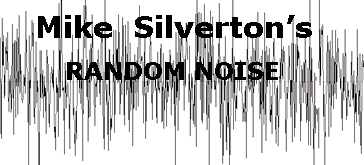
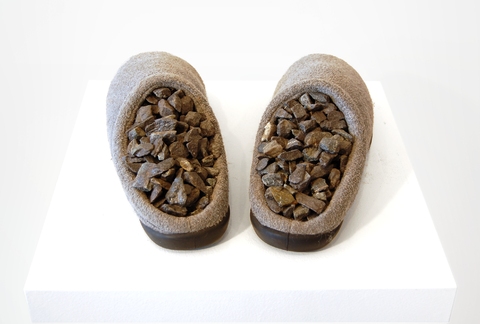
Random Noise 16
Acoustic Revive’s XLR-1.5 SPA Single-Core Line Cable,
SPC-PA 2.0 Single-Core Speaker Cable,
RIQ 5010 and RIQ 5010W Solid Natural Quartz Insulators,
and REM-8 EMF Canceller
Are we happy yet?
I give you the audiophile. Breakfast, lunch, between-meal snacks, the fellow dines on disquietude. And dinner too, but perhaps that’s harsh. Let’s say he strives – everywhere, in every direction – for that elusive dollop of audio mojo. “Yes, I hear it! Oh God, I’m so happy!”
And then, and then, alas, and then: he returns once again to – what shall we call it? – the default position. “There’s got to be more….” And that’s where I come in, dispensing hope and enlightenment. Don’t thank me. It’s what I do.
Let me begin by fessing up. I’m pixilated, as in beset by pixies. Bemused. Mystified. Flummoxed. Perplexed. This Acoustic Revive stuff has me muttering to myself. More of a lopsided interior colloquy, really, and none too friendly. Right there in the middle of my imagination I’m being taken to task by a particularly aggressive Audio Engineering Society type – wispy combover, pocket protector, short-sleeve shirt, Hush Puppies. And a sneer that won’t quit.
“You audiophiles are a such a joke! Ridiculous! Everyone’s laughing at you! You’ve lost all respect, the way you fantasize hearing differences that just aren’t there, not by any reasonable testing standard anyway.”
“But but but….”
“But me no buts. As a journalist, you have a responsibility to your reader. And here you are, you posturing ignoramus, gulling people into buying stuff that doesn’t make a damn bit of difference. How many double-blind tests do we need to perform to convince you nerds…?”
We are happy – for now
These measurements-tell-the-story types have been having at us subjectivists since the first tweakster raise his head above hi-fi’s primordial soup. Speaking of their grouchy ilk, a guy whose opinions I once took as Scripture – and repeated – saw no objection to lamp-cord cabling up to, maybe, a quarter-mile. The first time he laid eyes on an aftermarket power cord, he snorted, howled, growled and guffawed. For my part, these blinkered characters are welcome to wallow in their stats. I hear what I hear, and so, dear reader, do you, or you’d be spending your time elsewhere. So let’s get on with it. Because I can’t wait to sink my figurative teeth into Acoustic Revive’s quartz pucks and EMF Canceller, I’m putting off discussing AR’s relatively comprehensible interconnects and speaker cables toward the end of these remarks. For now, do I love them? I’ve already covered the power cord, line conditioner and acoustic panel in Random Noise 15. Between that column and this, my devotion has doubled. Euphoria’s tough to quantify.
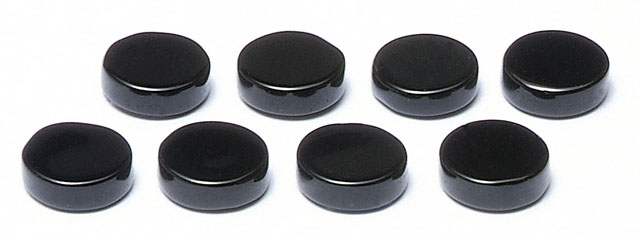
The RIQ 5010 and 5010W Quartz Insulators and REM-8 EMF Canceller share a common feature. They can get you into trouble – fortunately temporary, easily undone.
The RIQ 5010 and 5010W are pure quartz pucks, 1-3/4 inches across, a shave less than a half-inch thick, smoky and clear respectively, four to a box. I was sent two boxes of each for review. A move-by-move account of my puck shuffles would propel you into a stupor. I’ll summarize, with sincere thanks to Acoustic Revive’s Aki Monobe for his suggestions and recommendations.
The pucks can be used as footers. I removed Nordost’s trios of Quantum Points from under my two NuForce Reference 9 SE V2 amps (I work for NuForce) and replaced them with two smoky and two clear each. I liked what I was hearing. The pucks in this combination seemed to heighten clarity, especially in the treble, and add a measure of warmth, perhaps a touch more than I wanted. I replaced the smoky with clear, giving me four clear under each amp. I liked that better. The smoky quartz is said to have a more pronounced effect on the low end; clear, the highs – an imprecise albeit workable characterization. But:
A cautionary tale I’m conscience-bound to relate
That AES assailant reminds me of a test of many years past, cannot say when or where, but I’m pretty sure the story’s on the level. Seems that subjects were asked to evaluate speakers identical – they didn’t know this – save for the color of the enclosures. They reported that the brightly painted speakers sounded brighter than the speakers in dark enclosures. My impression that the smoky quartz darkens the sound raised a wee red flag, a mere shred of a thing. Well, to hell with it. I didn’t arrive at these conclusions overnight. In these familiar surroundings I’m content that my impressions square with what the system was, and is, sounding like.
An audiophile’s shell game
So, I thought (getting back to our narrative), let’s try a puck substitution with the Integris CDP. I removed the trio of steel points its designer, Derrick Moss, developed for this unit and replaced them with a quartet of doubled smoky pucks, having distributed my eight clear under the amps. Not good. The music lost definition. It sounded a little murky and blurred. I restored the steel points with renewed respect for Moss’s know-how. (In order to keep the RGC-24 Grounding Conditioner under the CDP, I doubled up the smoky pucks to compensate for the unit’s oversize faceplate.)
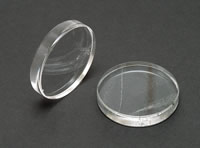 Further shuffling: with the two quartets of clear remaining under the amps, a smoky puck sat atop the IEC inlets of the RTP-2 Ultimate Power Taps, CDP and amps. Not bad, but I knew I’d continue to fuss. Every move makes a slight, sometimes difficult to describe difference. However – might as well say it now as later – the revelations these AR products, together, have brought about are anything but slight. This is a different system. A fine hi-fi got a good deal finer. The sound has achieved a fullness and texture new to this room. I’m getting a stronger sense of verisimilitude. Call it presence, a term in audio with a mixed reputation. (Are you old enough to remember those godawful presence controls? No self-respecting receiver was without one, preamps also. How about the Fletcher-Munson loudness contour? If you remember that one and you’re not wearing a hearing aid, my warmest congratulations.)
Further shuffling: with the two quartets of clear remaining under the amps, a smoky puck sat atop the IEC inlets of the RTP-2 Ultimate Power Taps, CDP and amps. Not bad, but I knew I’d continue to fuss. Every move makes a slight, sometimes difficult to describe difference. However – might as well say it now as later – the revelations these AR products, together, have brought about are anything but slight. This is a different system. A fine hi-fi got a good deal finer. The sound has achieved a fullness and texture new to this room. I’m getting a stronger sense of verisimilitude. Call it presence, a term in audio with a mixed reputation. (Are you old enough to remember those godawful presence controls? No self-respecting receiver was without one, preamps also. How about the Fletcher-Munson loudness contour? If you remember that one and you’re not wearing a hearing aid, my warmest congratulations.)
Setting the bantamweight NuForce amps atop four glass-smooth footers led to some sliding about. I arrived at a solution attractive to the eye and beguiling to the ear. Aki Monobe mentioned that the quartz need not be in direct contact with a component. Bearing that in mind, I applied bits of double-sided tape to the undersides of six clear pucks in order to create a slip-resistant trio of footers for each amp, two to the front, one to the rear. I then applied small pinches of Blu-Tack, a removable adhesive, to the undersides of six of Nordost’s Quasar Points and secured these to the tops of the six quartz pucks. The amps now sit securely atop trios of clear quartz and Quasar Points.
Trios rather than quartets freed up a pair of clear pucks, which I used as replacements for the smoky pucks I earlier placed over the amps’ IEC inlets. A smoky puck remained over the CDP’s IEC inlet. Can’t say it too often: the quartz works in subtle ways. Replacing smoky with clear atop the NuForce pair made a difference. However, replacing smoky with clear atop the line conditioners’ inlets and removing the quartz from atop the components’ inlets produced a more attractive result. I’m getting the kind of definition and resolution that answers a maiden’s prayers. Curiosity has deferred to contentment.
Where there’s smoke there’s – what?
I retired the smoky pucks. Two trios of clear mated with Quasar Points support the amps. The remaining two clear cover the two RPT-2 Ultimate Power Taps’ IEC inlets. For this system and my listening tastes, the clear RIQ-5010W Solid Natural Quartz Insulators work best. More out of curiosity and, to be honest, insecurity, at a point at which I was playing about with a pair of REM-8’s, I replaced the line conditioners’ clear pucks with smoky, once again deciding that, for this system, smoky doesn’t do it. The sound had thickened ever so slightly.
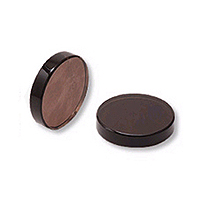 Further smoky experimentation – placing them, for example, near the CDP and amps’ inlets, but not touching – produces a plummier midrange. This has been fascinating. I suspect that in general the smoky quartz is rather more potent than the clear. Without understanding the significance of it, I’ve also discovered that in handling the dark pucks they cling together in a mildly magnetic way, the clear much less so.
Further smoky experimentation – placing them, for example, near the CDP and amps’ inlets, but not touching – produces a plummier midrange. This has been fascinating. I suspect that in general the smoky quartz is rather more potent than the clear. Without understanding the significance of it, I’ve also discovered that in handling the dark pucks they cling together in a mildly magnetic way, the clear much less so.
If my rambling account leaves you confused, no worries. I’m merely suggesting that the quartz calls for experimentation. Have another look at Ken Ishiguro’s listening room (see Clement Perry’s photo essay of his visit to Acoustic Revive), paying particular attention to where Ishiguro distributes the quartz. Whether to spring for clear or smoky might depend, one, on your bankbook’s health, and two, on whether you’d like your system to sound plumper or leaner. Or different. Or whatever. The quartz is rich in little surprises. And expensive: a box of four goes for $625 US. The material’s in limited supply and may unavailable in the not too distant future.
No less mysterious
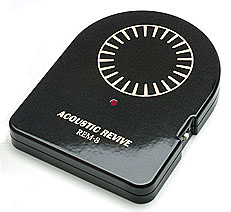 I asked Aki Monobe whether the small, battery-powered REM-8 EMF Canceller is a scaled-down Schumann Resonance generator. No. Although it operates, like the RR-77, at 7.83 Hz, it produces what Aki calls a Zero Magnetic Field. This leaves me confused. I thought the 7.83 Hz pulse and the global phenomenon known as the Schumann Resonance are synonymous. Oh well. To quote Izzy, the ancient waiter at Moscowitz’s Dairy Restaurant, when summoned by a customer, “Dot’s not my tebble.” Explaining, or for that matter understanding, what goes on inside these AR devices, dot’s not my tebble. I merely report on what I hear things doing – and what a relief that is!
I asked Aki Monobe whether the small, battery-powered REM-8 EMF Canceller is a scaled-down Schumann Resonance generator. No. Although it operates, like the RR-77, at 7.83 Hz, it produces what Aki calls a Zero Magnetic Field. This leaves me confused. I thought the 7.83 Hz pulse and the global phenomenon known as the Schumann Resonance are synonymous. Oh well. To quote Izzy, the ancient waiter at Moscowitz’s Dairy Restaurant, when summoned by a customer, “Dot’s not my tebble.” Explaining, or for that matter understanding, what goes on inside these AR devices, dot’s not my tebble. I merely report on what I hear things doing – and what a relief that is!
We begin our REM-8 adventure at the least promising turn on our path to the Eternal Whatever. Having read Acoustic Revive’s Web site statement that the EMF Cancellers work as effectively with switching amps as they do with large transformers, I requested three. Aki obliged, with a word of caution: the effect of three can be extractive. I soon confirmed. One REM-8 under the CDP’s toroidal transformer and two under the NuForce pair’s power supplies had a bleaching effect. Further, at $550 US per, the reader might well demur at acquiring more then one. An Acoustic Revive dealer might be able to lend you the REM-8, a set or two of quartz pucks, or whatever else you’d like to check out. Contact LotusGroupUSA.com for dealer information.
I positioned a solo REM-8 at various spots atop and under the CDP and really couldn’t say that much of anything happened in the way of difference. I was disappointed, more in myself than in the product. It pained me to have to report that what must be one of Ken Ishiguro’s most original designs seemed pointless.
I’d hesitate to state my frustration quite so bluntly had I achieved, finally, anything less than sweet-spot contentment. Investigating where the RGC-24 Grounding Conditioner should go a little more thoroughly than I had earlier done, I repositioned it under the CDP’s toroidal transformer to the right of the transport and placed a REM-8, face down, over the CDP’s power supply to the left of the transport. Enlightenment arrived before first light, at another of my too early listening sessions. The effect of a REM-8 in this position resembles that of the RR-77: the stereo image became a little more real.
So, why not try a second REM-8 on the other side of the transport lid, which would put it over the toroidal transformer? While three may have been a problem where I’d earlier placed them, I’ve had the REM-8 pair in their present location long enough, removing them singly or together often, to feel secure in what I hear: an uptick in the kind of quality the RR-77 brings to the system. While the REM-8 and RR-77’s missions may differ, I cannot differentiate the benefit they bring. It seems to this listener (I’m repeating myself) that the REM-8 accomplishes in miniature what the RR-77 does roomwide. The RR-77 operates optimally from an elevated position in the listening room, and that’s about it with respect to location. The REM-8’s placement is far more critical. I’ve found after further listening that going from two to one doesn’t entail much of a sacrifice. One REM-8, at first atop and later under the CDP’s power supply more than satisfies. (If you put a REM-8 on top of a component, it goes face down; if under, face up.)
Interesting aside: rather than turning them off to conserve the two AAA batteries these little fellows run on, I accidentally left the REM-8 pair in the on position several times. When I remembered to look the following day, their flashing LEDs were still going strong. I asked Aki about this. Seems that you can leave a REM-8 on for about three months. You’ll know when the batteries need to be replaced when the LED begins to dim.
Cables, at last!
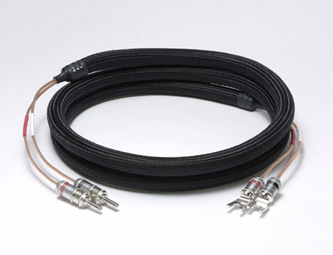 I explained in my earlier report that I formed my impressions of Acoustic Revive’s power cords, line conditioners, and room panels by way of Nordost’s Valhalla balanced interconnects and Tyr speaker cables. When I wrote about them a couple of years ago, I judged Tyr on a par with the (then) top-of-the-line Valhalla speaker cable, but preferred the Valhalla balanced interconnect to the Tyr. The Nordost pairing is as open and engaging as the big, blue sky. That said, Acoustic Revive’s interconnects and speaker cables have impressed me as extraordinary in a way I can best characterize as familial.
I explained in my earlier report that I formed my impressions of Acoustic Revive’s power cords, line conditioners, and room panels by way of Nordost’s Valhalla balanced interconnects and Tyr speaker cables. When I wrote about them a couple of years ago, I judged Tyr on a par with the (then) top-of-the-line Valhalla speaker cable, but preferred the Valhalla balanced interconnect to the Tyr. The Nordost pairing is as open and engaging as the big, blue sky. That said, Acoustic Revive’s interconnects and speaker cables have impressed me as extraordinary in a way I can best characterize as familial.
Everything bearing the Acoustic Revive label emerges like little Athenas from Ken Ishiguro’s fertile mind. While unique as a group, AR’s power cords, speaker cables and interconnects share similar features and materials: varying gauges of oval PCOCC-A wire (annealed, uni-crystal copper manufactured by the Ohno Continuous Casting method) sheathed in polyolefin (a kind of polymer); covering this, a silk sleeve woven to AR’s requirements; over the silk, a spiral of Teflon-coated copper tubing; and finally, an outer covering of a carbon-content mesh, with elegant terminations modified or made to AR’s specifications. For photographs and texts, see Acoustic-Revive.com.
AR’s cables sound as right as they look. In the matter of speed, dynamic finesse, timbral accuracy, harmonic texture, topside extension, low-end substance and imaging, this is as good as I’ve heard in this room. But of course my opinion is assisted by every AR item I’ve covered. I hear Ken Ishiguro’s designs and innovations aiming at a unified goal. However, I offered in that earlier AR essay that the RWL-3 Room Tuning Panels would most likely work their magic with any of good cabling and line conditioning, likewise the RR-77 Ultra Low Frequency Pulse Generator, RD-3 Disc Demagnetizer, and RIO-5 Negative Ion Generator. Before you ditch your electronics or speakers, you’d do well to look into these.
The RTP Ultimate Power Taps, Single-Core Line and Speaker Cables are also likely to add to your pleasure, tho in recommending these I do understand that many readers will already have acquired costly cabling and line conditioning they’re in no rush to toss.
The 1.5m balanced XLR-PA Single-Core Line Cable (interconnect) pair I’m using lists in the US for $1200. The RCA equivalent is $1125. The 2m SPC-PA Single-Core Speaker Cable lists for $1650. As mentioned in the earlier review, a 2m Power Reference Power Cord lists for $725; an RTP-2 Ultimate Power Tap, $1295.
Final thoughts
If you occupy that stratum where self-indulgence causes no pain, by all means, go for the lot. If you need to prioritize, my experience with them suggests that the RIQ-5010 and -5010W Solid Quartz Insulators require time and patience, as does the REM-8 EMF Canceller. They will reward your efforts. But given their price, whether to recommend clear or smoky quartz remains a stumbling block. As mentioned above, I get a happier result with clear. Here, I think, the abovementioned dealer loan is certainly in order. Not so, perhaps, with the REM-8. Once you hit upon an optimal location, it’s all to the good.
From childhood on, my love of music grew; likewise, as an adult, I developed an enthusiasm for well produced recordings – as a parallel but separate art – which, of necessity, enfolds an interest in the kind of hardware that helps me sort good from mediocre. A few days ago I played a disc featuring the violinist Anne-Sophie Mutter in performances of Henri Dutilleux’s Sur le même accord, Bela Bartók’s second violin concerto, and Igor Stravinsky’s Concerto en ré. The disc, Deutsche Grammophon B0004049-02, is a compilation of earlier releases of different ensembles and venues. The Dutilleux, performed with the Orchestre National de France, Kurt Masur conducting, recorded live by Radio France, plays in the listening room as a judicious exercise in minimal miking. The listener has a keen sense of a space and dynamic. A pleasure. In sorry contrast, the Bartók concerto, with the Boston Symphony, Seiji Ozawa conducting, exemplifies multi-miking’s billboard effect. The soloist might as well have been in a different space.
If you’re not familiar with the name, Jimmy Guiffre is a clarinetist who, with pianist Paul Bley and acoustic bassist Steve Swallow, recorded two albums in 1961, Fusionand Thesis, that took jazz in a new, beautifully subdued direction. A two-CD reissue on ECM 1438 / 39 849 644-2, issued in 1992, is among my collection’s pleasures. Steve Lake’s fine notes mention Giuffre’s indebtedness to a chamber work by Claude Debussy, the 1915 Sonata for Flute, Viola and Harp. This I hadn’t played in a long while. A three-CD compilation of Debussy’s chamber music on Delos DE 3167, issued in 2000, offers a fine performance by members of the Chamber Music Society of Lincoln Center, who perform singly, in duos, trios and a quartet on all three discs.
After I played the trio, I listened to the composer’s 1917 Sonata for Violin and Piano on the same CD, a John Eargle recording, which the trio is not. Beautiful sound throughout – I’ve never had more pleasure from this system – but worlds apart. The Eargle is as fine a chamber-music recording as you’re likely to hear. The man’s a master. If anything, with the music I mention here, and with everything I’ve played, differences in recording technique and quality are easier to discern. Rather than homogenizing sound – creating a euphonic effect – together, these AR products contribute to a clearer vista on difference.
This has been one hell of a ride. 
![]()
Don’t forget to bookmark us! (CTRL-SHFT-D)
Stereo Times Masthead
Publisher/Founder
Clement Perry
Editor
Dave Thomas
Senior Editors
Frank Alles, Mike Girardi, Key Kim, Russell Lichter, Terry London, Moreno Mitchell, Paul Szabady, Bill Wells, Mike Wright, Stephen Yan, and Rob Dockery
Current Contributors
David Abramson, Tim Barrall, Dave Allison, Ron Cook, Lewis Dardick, Dan Secula, Don Shaulis, Greg Simmons, Eric Teh, Greg Voth, Richard Willie, Ed Van Winkle, and Rob Dockery
Music Reviewers:
Carlos Sanchez, John Jonczyk, John Sprung and Russell Lichter
Site Management Clement Perry
Ad Designer: Martin Perry





Be the first to comment on: Random Noise 16